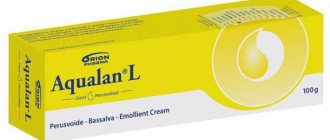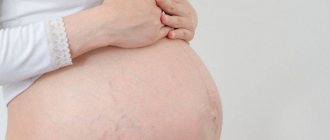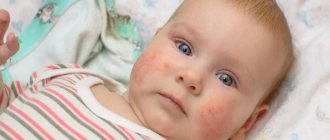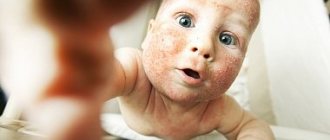Dermatitis in children
Symptoms of atopic dermatitis
Usually manifests in the first half of life;
less often develops in preschool, school or adolescence. Skin rashes with atopic dermatitis in children can be represented by persistent hyperemia or transient erythema, dryness and flaking of the skin, or a weeping papular-vesicular rash on an erythematous background. Characteristic signs of atopic dermatitis in children include symmetry of skin lesions on the face, limbs, and flexor surfaces of joints; itching of varying intensity. Quite often, with atopic dermatitis in children, folding (hyperlinearity) of the palms and soles is detected; follicular hyperkeratosis of the elbows, forearms, shoulders; white dermographism, skin scratching, pyoderma, hyperpigmentation of the eyelids (“allergic radiance”), cheilitis, urticaria, keratoconus, recurrent conjunctivitis, etc. The natural progression of atopic dermatitis in children in the absence of proper treatment can become the so-called “atopic march” or atopic disease , characterized by the addition of other allergic diseases: allergic conjunctivitis, allergic rhinitis, bronchial asthma.
Symptoms of seborrheic dermatitis
This type of dermatitis occurs in approximately 10% of children in the first 3 months of life and completely stops by 2-4 years. The first manifestations of seborrheic dermatitis in a child may appear as early as 2-3 weeks of life. At the same time, grayish scalp-like scales (gneiss) are formed on the scalp, which, merging, turn into a continuous greasy crust. Gneiss can spread to the skin of the forehead, eyebrows, and behind the ear; sometimes maculopapular rashes, covered with scales on the periphery, are found in the natural folds of the torso and limbs.
Distinctive features of seborrheic dermatitis in children are minimal itching and absence of exudation (scales are greasy, but dry). When the crusts are forcibly removed, brightly hyperemic skin is exposed; in this case, it can become wet and easily become infected.
Symptoms of diaper dermatitis
Diaper dermatitis is characterized by irritation of the skin of the buttock area, inner thighs, perineum, lower back, abdomen, i.e., areas of the skin in contact with wet and soiled diapers, diapers, and onesies. Diaper dermatitis occurs in 35-50% of infants, most often developing in girls aged 6 to 12 months.
Depending on the severity of clinical manifestations, there are 3 degrees of diaper dermatitis. With mild manifestations of dermatitis in children, moderate skin hyperemia, a mild rash and maceration of the skin in areas of typical localization occur. Moderate diaper dermatitis is characterized by the formation of papules, pustules and infiltrates on irritated areas of the skin. Severe diaper dermatitis in children occurs with the opening of blisters, the formation of areas of weeping and erosion, and extensive drainage infiltrates.
The development of diaper dermatitis affects the general well-being of children: they become restless, cry often, sleep poorly, since the inflamed areas of the skin are very itchy, and touching them causes discomfort and pain. In girls, diaper dermatitis can lead to the development of vulvitis.
Symptoms of contact dermatitis in children
Manifestations occur directly on the area of the skin that came into contact with any irritant. The main signs of contact dermatitis in children include edematous hyperemia of the skin with sharp boundaries, severe itching, burning, soreness, and the formation of blisters, the opening of which leads to the formation of weeping erosive areas.
Contact dermatitis in children can take an acute or chronic course. The acute phase begins immediately after contact with the irritant and ends shortly after the end of exposure. Dermatitis in children acquires a chronic course after frequent repeated exposure to an aggressive factor.
Diaper dermatitis - symptoms and treatment
The prognosis is favorable. In the vast majority of cases, the disease is not dangerous and, as a rule, does not require specific medications. It usually goes away on its own after stopping the use of diapers and performing proper skin care [18].
To prevent diaper dermatitis, a set of measures is used: ABCDE (abbreviation for English words):
- A - air (air);
- B—barrier;
- C - cleansing (cleansing);
- D - diapering (diaper changing)
- E - education (training).
Air - air . This means frequent air baths when the child is not wearing a diaper. It is recommended to carry out air baths for at least 5-10 minutes when changing a diaper [19].
Barrier - barrier . Use of protective creams. Their application is necessary every time you change diapers. Most often they contain zinc, dexpanthenol, petroleum jelly, and lanolin. These creams create a protective film that separates the skin from the irritating effects of urine and feces.
Cleansing - cleansing . If the skin in the diaper area is inflamed, a daily bath will help remove irritants and reduce the risk of fungal and bacterial infections. Cleaning is carried out with water, it should be gentle, you can use cotton balls or cotton cloth. Baby wipes should only be used on intact skin. They should not contain parabens, alcohol, fragrances, irritants or allergens, and the pH should be neutral. After bathing, you need to gently pat your skin with a towel, avoiding friction [20].
Diapering - changing diapers . Diapers should be changed every 2 hours (every hour for newborns) or after each bowel movement or urination. It is better to choose a diaper with high absorbency. The better the diaper absorbs, the better it keeps the skin dry. Although there is currently no data showing which type of diaper is best for preventing diaper rash, cloth diapers are generally less absorbent than most disposable diapers. If a child develops diaper dermatitis while using cloth diapers, then it is better to switch to disposable diapers during the illness. You need to make sure that the diaper is not too tight, especially when worn at night. A loose diaper will rub less against your skin. Let your baby's skin dry completely before putting on a new diaper. It is also important to prevent the sticky pads from sticking to your baby's skin. Hands should be washed before and after changing diapers to prevent the spread of germs that have caused infection on the baby's skin [21].
Education - training . Educating parents on proper child care is important. It is necessary to provide them with clear instructions regarding daily skin care and information about which skin care products are beneficial and which may be harmful [22].
How is atopic dermatitis diagnosed? Criteria for diagnosing blood pressure
When diagnosing atopic dermatitis, in addition to immunological laboratory blood tests, the key is to analyze the patient's skin condition and its symptoms in accordance with the criteria of Williams and colleagues or the criteria of Hanifin and Raika.
Atopic dermatitis (AD) is a chronic disease with a complex cause. Its appearance is influenced by immunological, genetic, non-immunological and environmental factors. Therefore, this is not just an allergic reaction. For this reason, the basis for correct diagnosis of AD is the overall picture of the disease, especially the appearance of the skin.
Atopic dermatitis is a disease that causes diagnostic problems - similar symptoms can occur with other types of dermatitis, such as seborrheic or sweat dermatitis, contact eczema, mycosis or psoriasis. The most common diagnosis of atopic dermatitis is the so-called Williams and colleagues criteria or Hanifin and Reike criteria.
Seborrheic dermatitis
Psoriasis
Williams criteria for diagnosing AD
According to the Williams criteria, to diagnose atopic dermatitis, it is necessary to establish whether itching has occurred within the last year and at least 3 of 4 symptoms:
- involvement of skin folds (elbow and knee), changes in the neck or around the eyes;
- coexistence of other atopic diseases, for example, bronchial asthma or hay fever (when diagnosing children under 4 years of age, atopic diseases in 1st degree relatives are taken into account);
- general dry skin throughout the year;
- visible inflammatory changes in the flexion areas of the limbs and on the cheeks/forehead and elongated parts of the limbs in children under 4 years of age or onset of the disease before the age of 2 years (not applicable if the child is under 4 years of age).
Diagnosis of atopic dermatitis (AD): skin tests
When diagnosing atopic dermatitis, in addition to analyzing symptoms and laboratory tests, a series of skin tests, such as skin tests, atopic patch tests, or nutritional skin exposure tests, are performed to identify the substances responsible for an excessive allergic reaction.
The diagnosis is confirmed by immunological laboratory tests - determining the concentration of IgE antibodies - and a number of skin tests that can identify allergens responsible for an excessive allergic reaction.
Review of remedies for atopic dermatitis
What products should be used to combat atopic dermatitis?
Anna Trushina, a dermatologist at the DocDeti clinic, will talk about the means used to treat and prevent atopic dermatitis.
Atopic dermatitis is a chronic inflammatory skin disease. And to treat it, you need products for external use that affect the skin.
What medications are there?
For basic, permanent therapy, products with emollients are used. Such products are aimed at prevention and help relieve exacerbations.
Emollients soften, moisturize the skin, and replenish its barrier function. They increase the effectiveness of anti-inflammatory therapy, resist itching, skin soreness and eliminate flaking.
Release forms:
- Lotion and milk are the lightest form. They apply well in a thin layer, but the moisturizing effect is minimal. The product can be applied to hairy areas of the skin and to areas of acute inflammation.
- Creams are denser products than milk and lotions, but they are also comfortable to use. They can be used throughout the day - there will be no greasy residue left.
- Ointments and balms are the thickest and densest forms, good for very dry skin, thickened skin, with severe peeling, as well as for nighttime care.
What's within your means?
There is a large selection of available emollients on the market: La roche posay Lipikar, Bioderma Atoderm, Uriage Xemose, Topicrem DA, A-derma Exomega, Avene Xerocalm, Noreva Xerodiane, Emolium, Atopic, Cerave, Eucerin and many other products.
Something more serious
In case of exacerbation and the appearance of foci of inflammation, the doctor may prescribe reparants
- they speed up healing and relieve irritation. Products are used only in problem areas, and not on the entire skin. They do not replace products with emollients!
There are two forms of release of reparants; liquid lotion and balm or cream. It is not difficult to find these drugs in pharmacies - most contain Cica in their names.
Liquid medications help relieve inflammation and are often prescribed in a short course. These are Avene Cicalfate lotions, Bioderma Cicabio and Uriage Bariederm Cica spray.
Reparants in the form of creams and balms are used if necessary: A-derma dermalibur, La roche posay Cicaplast, Topicrem Cica, Avene Cicalfate (in the form of cream), Bioderma Cicabio (in the form of cream), Uriage Bariederm Cica (in the form of cream).
Nothing helps
There are cases when emollients and reparants cannot cope, then drug therapy comes to the rescue (prescribed by a dermatologist!).
1. topical glucocorticosteroids (hormones)
A large number of studies have confirmed that the drugs are effective and not dangerous when used externally. But remember that the attending physician must monitor the process.
GCS differ greatly from each other in terms of active substances, form and form of release of products (emulsions, creams, ointments, sprays, and so on).
2. calcineurin inhibitors - pimecrolimus and tacrolimus
Group of anti-inflammatory drugs. These are non-hormonal products that can help in delicate areas: facial skin, diaper area, folds - where the use of hormonal products is limited. These drugs are also suitable for long-term therapy.
3. antibiotic, antifungal drug
Prescribed alone or in combination with other medications if a complication occurs due to a secondary infection.
Additionally
The doctor may recommend syndets - products that cleanse the skin when bathing; they replace shower gel and soap.
Stop list
The pharmacy offers a wide selection of tar, ichthyol, and naphthalene preparations, but it is important to know that they are not treatments for atopic dermatitis.
Skin testing (STP)
Skin prick tests test for a specific allergen. This test is based on the fact that IgE antibodies are present on the surface of immune system cells. The purpose of the test is to bring such cells into contact with the allergen.
A solution containing the allergen is applied to the patient's skin, and then it is pricked with a special lancet. Typically, this test tests several substances at the same time, such as dust, hair or pollen.
Skin tests
This test is no different from a test that determines an allergy to any substance. Therefore, the presence of a positive allergic reaction does not automatically mean atopic dermatitis. In addition to the allergic reaction, other symptoms such as dry and itchy skin should also appear. Additionally, a negative test result does not mean that the disease is not AD; it only means that this set of substances does not cause allergic reactions.
How to recognize atopic dermatitis?
Tests often used in diagnosis are skin tests and atopic patch tests, but a negative test does not always mean that the disease is not present, it may only mean that the allergen has not yet been detected.
The laboratory also performs total serum IgE determinations, which determine the patient's allergies. Since atopic dermatitis is an allergic disease, we cannot completely cure it, we only treat it symptomatically. In some cases, it is possible to desensitize the patient.








